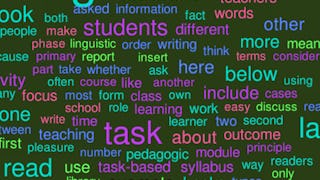In this course, you will learn how to design assessments around the needs of your ELL students and their language level. You will learn how to incorporate language and content requirements for both formative and summative assessment types. You will learn to assess your ELL students through the use of project and task-based assignments. You will learn to use and modify rubrics to align to and measure student achievement of your language and content learning objectives. The course will also briefly cover strategies for supporting ELL students during standardized testing.

Gain next-level skills with Coursera Plus for $199 (regularly $399). Save now.

Assessing Achievement with the ELL in Mind
This course is part of ELL Success in the Content Classroom: Teacher Toolbox Series Specialization


Instructors: Claire McLaughlin
5,016 already enrolled
Included with
(92 reviews)
Skills you'll gain
Details to know

Add to your LinkedIn profile
See how employees at top companies are mastering in-demand skills

Build your subject-matter expertise
- Learn new concepts from industry experts
- Gain a foundational understanding of a subject or tool
- Develop job-relevant skills with hands-on projects
- Earn a shareable career certificate

There are 6 modules in this course
Welcome to week 1 of the course! The material presented in the lessons this week is key to understanding assessments and its impact on ELLs. By the end of this module, you will be able to identify the purpose of different types of assessment, identify key concepts in authentic assessment, understand the difficulties associated with assessing ELLs, review language and learning objectives within a lesson or unit plan for assessment purposes, apply techniques for authentic assessment design using specific questions as criteria. Let's get started!
What's included
10 videos3 readings5 assignments
Welcome to week 2 of the course! The lessons this week focus a bit more specifically on the different types of assessment and how they uniquely impact our ELLs. We hope that you find some helpful strategies in the lessons provided. By the end of this module, you will be able to: identify purposes of formative and summative assessment types, employ a variety of formative assessments in the content classroom while keeping in mind ELL language acquisition, design plenary activities within the lesson plan as a means of formative assessment design summative assessments in the content classroom while keeping in mind ELL language acquisition, use “can-do” statements as a means of describing assessment criteria for language and content objectives. Let's get started!
What's included
10 videos6 readings4 assignments
Welcome to week 3 of the course! This module will give you an opportunity to take a look at some of the ways that you can create and modify the assessments you use in your class. By the end of this module, you will be able to: use alternative assessment formats to best assess your ELL, create modified assessments to allow for content assessment of ELLs at any language level, use visual assessments for basic-level ELLs, apply a variety of support strategies for assessment, and assign appropriate grades for modified assessment. Let's get started!
What's included
10 videos6 readings4 assignments
Welcome to week 4 of the course! This module covers the hot topic of grading and the many ways that ELLs are impacted by grading. By the end of this module, you will be able to use peer-and self-assessment strategies specified for your content classroom, design rubrics for peer-and self-assessment specified for your content classroom and/or lesson, design rubrics appropriate for assessment of content and necessary language objectives for your ELL, identify appropriate use of linguistic error correction in assessment. Let's get started!
What's included
10 videos7 readings4 assignments
Welcome to week 5 of the course! We are excited to focus on project based assessment in this module and the many benefits it can have when assessing ELLs. By the end of this module, you will be able to: understand the impact of project and task-based learning and assessment, align project and task-based assessment to learning and language outcomes, design project and task-based assessments, use scaffolding strategies for project and task based assessment, use revision in project and task-based projects as a means of encouraging summative assessment grades. Let's get started!
What's included
10 videos8 readings5 assignments
Welcome to week 6! Congratulations and well done. It is now time to apply the many strategies for lesson planning with the ELL in mind to your own teaching context. By the end of this module, you will be able to synthesize course material, complete the final exam and complete the optional peer review. Good luck!
What's included
1 video2 readings1 assignment1 peer review
Earn a career certificate
Add this credential to your LinkedIn profile, resume, or CV. Share it on social media and in your performance review.
Instructors


Offered by
Explore more from Education
 Status: Free Trial
Status: Free TrialArizona State University
 Status: Free Trial
Status: Free TrialArizona State University
 Status: Free Trial
Status: Free TrialRice University
 Status: Preview
Status: PreviewUniversity of London
Why people choose Coursera for their career




Learner reviews
92 reviews
- 5 stars
72.82%
- 4 stars
16.30%
- 3 stars
4.34%
- 2 stars
4.34%
- 1 star
2.17%
Showing 3 of 92
Reviewed on Mar 19, 2019
I strongly recommend this course since it unveils important facts about the evaluation process for educators and students as well.
Reviewed on Aug 20, 2016
Very informative and helpful in assisting teachers with learning how to assess their ELL students.
Reviewed on Dec 19, 2015
WOW! I learned so much my head is spinning--EXCELLENT Course!Amazing Content! Fantastic Examples! Well Organized! Superb Teachers!Thank you for the opportunity to learn!

Open new doors with Coursera Plus
Unlimited access to 10,000+ world-class courses, hands-on projects, and job-ready certificate programs - all included in your subscription
Advance your career with an online degree
Earn a degree from world-class universities - 100% online
Join over 3,400 global companies that choose Coursera for Business
Upskill your employees to excel in the digital economy
Frequently asked questions
To access the course materials, assignments and to earn a Certificate, you will need to purchase the Certificate experience when you enroll in a course. You can try a Free Trial instead, or apply for Financial Aid. The course may offer 'Full Course, No Certificate' instead. This option lets you see all course materials, submit required assessments, and get a final grade. This also means that you will not be able to purchase a Certificate experience.
When you enroll in the course, you get access to all of the courses in the Specialization, and you earn a certificate when you complete the work. Your electronic Certificate will be added to your Accomplishments page - from there, you can print your Certificate or add it to your LinkedIn profile.
Yes. In select learning programs, you can apply for financial aid or a scholarship if you can’t afford the enrollment fee. If fin aid or scholarship is available for your learning program selection, you’ll find a link to apply on the description page.
More questions
Financial aid available,
¹ Some assignments in this course are AI-graded. For these assignments, your data will be used in accordance with Coursera's Privacy Notice.

